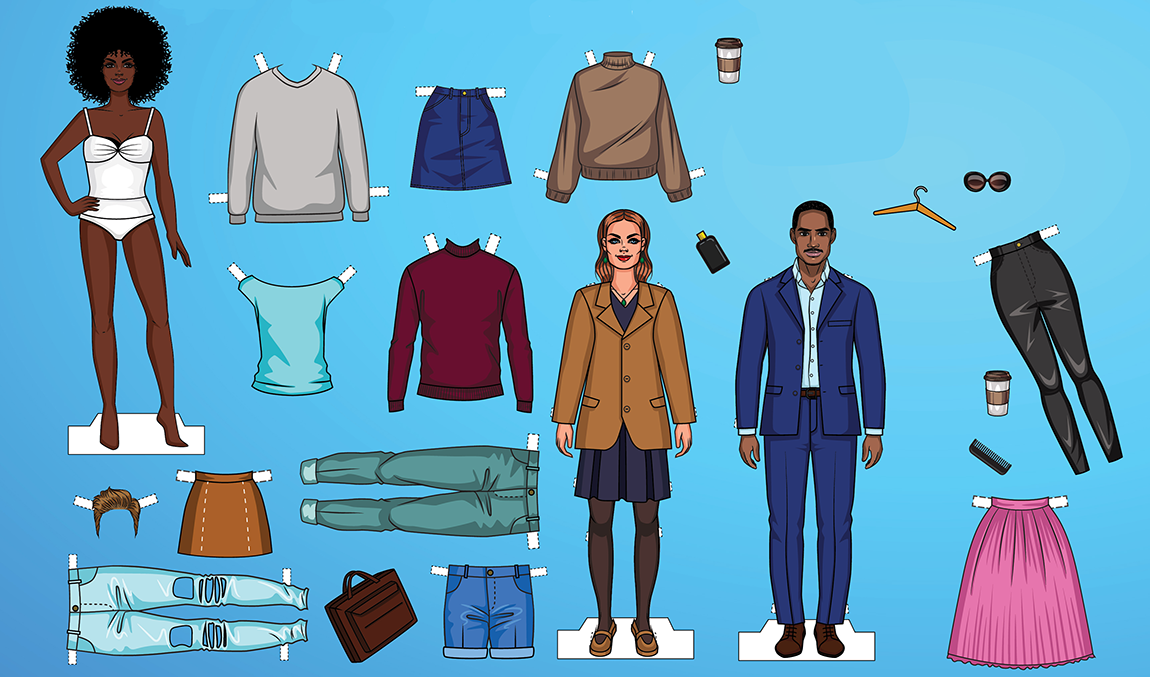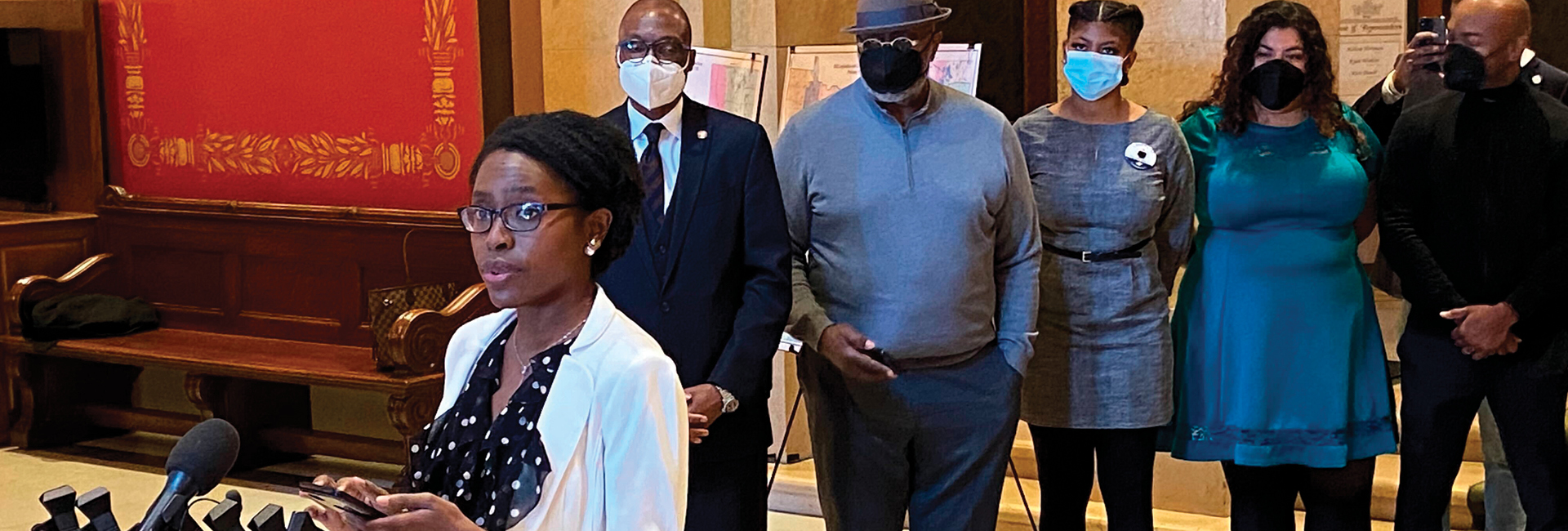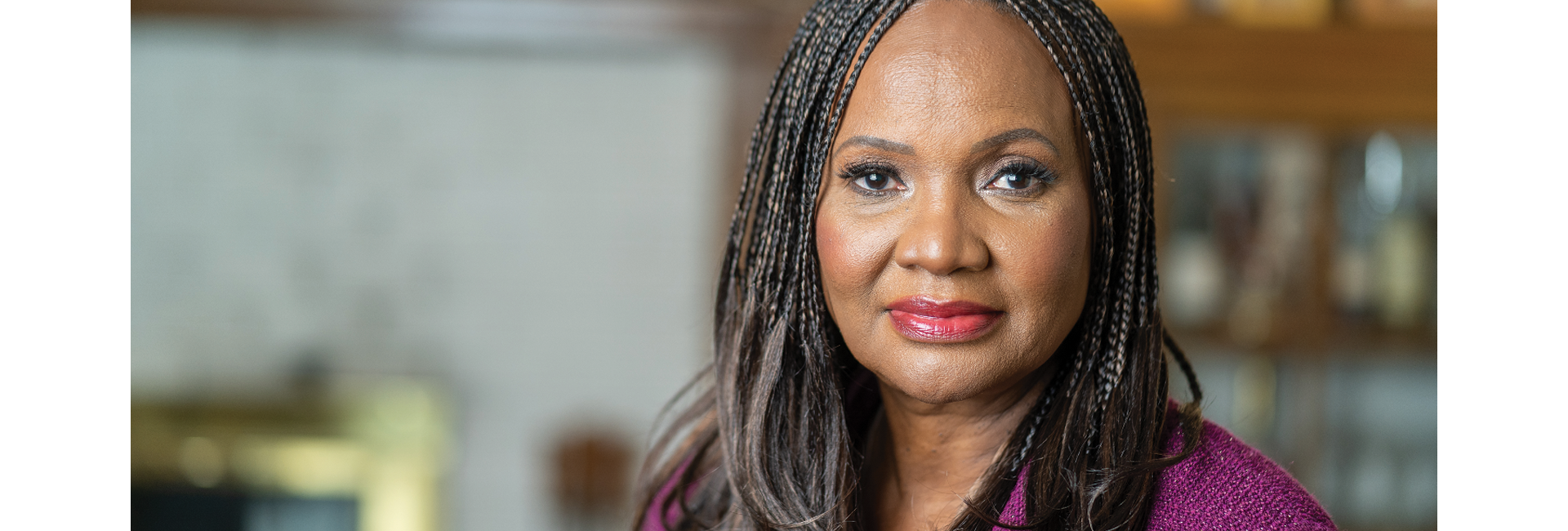
When attorney Lisa Borden enters Alabama prisons to see clients, female officers of the state department of corrections routinely ask her to prove she meets the stated requirement that “visitor(s) must wear a complete set of undergarments.” She knows of no men who have been asked to show their underwear.
Attorney Delilah Clay, who is Black, decided to stop straightening her hair and wear locks. A white male lawyer who was unfamiliar with the process of locking hair asked her what type of statement she was trying to make. No statement, she replied: just showing up as her authentic self.
When M. Dru Levasseur interviewed for a summer associate position, he was early in his transition—but hiding it was not an option. He says he faced “blatant discrimination” during interviews, with one attorney stating, “There [are] no gay people” at the firm. Levasseur understood that as, “Oh, I am not welcome here.”
Joy Moonan, an attorney who has cerebral palsy and uses a wheelchair, wears dress pants with elastic waistbands and casual footwear like tennis shoes to accommodate her bathroom needs. She’s often had to explain to colleagues that medical necessity, not lazy grooming, requires avoiding typical lawyer suits.
Dress code expectations for lawyers are evoked in the name of professionalism and steeped in tradition. But advocates say that centuries-old grooming dictates have negatively impacted people of color, women, those with disabilities and LGBTQ folks and need to evolve.
Many question their necessity. “If you work in an industry where your hair could get caught in machinery, maybe there’s specific instances where dress codes could be justified,” says Borden, Southern Poverty Law Center’s senior policy counsel for international advocacy in Birmingham, Alabama. But law isn’t one of them, she adds. “I don’t see how it can be.”
"It is remarkable how many attorneys appear inappropriately on camera." —Dennis Bailey
Early in the pandemic, however, when many court proceedings moved online, then-Judge Dennis Bailey of the 17th Circuit of Florida underscored the importance of decorum and dressing appropriately.
“It is remarkable how many attorneys appear inappropriately on camera,” Bailey wrote. “We’ve seen many lawyers in casual shirts and blouses, with no concern for ill-grooming, in bedrooms with the master bed in the background, etc. One male lawyer appeared shirtless, and one female attorney appeared still in bed, still under the covers.”
U.S. federal law doesn’t directly regulate employer dress code policies, but the First Amendment protects freedom of expression, and Title VII of the Civil Rights Act of 1964 protects employees from discrimination based on sex, race, color, religion and national origin. Dress codes should be uniformly enforced, according to the Equal Employment Opportunity Commission. State and local laws vary.
Common hairstyles in the Black community may be unfamiliar to some white people, says Richard Thompson Ford, a Stanford Law School professor.
“When they see that hairstyle for the first time, they have a harder time judging as to whether it’s professional,” says Ford, author of Dress Codes: How the Laws of Fashion Made History.
“The default historically had been, ‘If I’m not familiar with it, it’s unprofessional, it’s weird, it’s some kind of radical statement, it’s countercultural—and that doesn’t belong in the workplace.’”
"Subconsciously, you say to yourself, 'If a Supreme Court justice can wear hair like that, why can't I?'" —Deborah Enix-Ross
Of the 1.3 million U.S. lawyers, 4.5% are African American, according to the 2022 ABA Profile of the Legal Profession.
Some Black lawyers say they would straighten their hair for job interviews, in company photos or for court appearances, especially early in their careers. But as they became more confident, some women like Clay, now an assistant vice president of legislative affairs at AT&T in Sacramento, California, changed to a more natural look.
Clay made that choice as she moved from Chicago to California in 2016 and shifted careers. “If they don’t want me like this, then they don’t want me,” she says. She now has locks.
Title VII prohibits discrimination because of a person’s immutable—or unchangeable—characteristics. “The courts were early on aware of the fact that to require someone to chemically straighten their hair was tantamount to race discrimination,” Ford says. “So they got that.”
The 11th U.S. Circuit Court of Appeals in Atlanta, however, ruled in Equal Employment Opportunity Commission v. Catastrophe Management Solutions (2017), in which a Black job applicant’s employment offer was rescinded when she refused to cut off her dreadlocks, that changeable hairstyles like dreadlocks are not protected. Styles are not considered a result of natural hair texture but are “artifice,” Ford says.
"The default historically had been, 'If I'm not familiar with it, it's unprofessional, it's weird, it's some kind of radical statement, it's countercultural—and that doesn't belong in the workplace.'" —Richard Thompson Ford
That means if a Black woman is wearing an Afro, she has an actionable claim of racial discrimination under Title VII as well as the 1866 Civil Rights Act, says Wendy Greene, a professor at Drexel University Thomas R. Kline School of Law in Philadelphia. If, however, she has her hair twisted, blocked or in locks like U.S. Supreme Court Justice Ketanji Brown Jackson’s, there is no protection.
“I find this to be unjust and really nonsensical,” Greene says. “Employers are free to regulate and discriminate and harass and subordinate their Black employees who are rocking locks, braids and twists.”
A recent study shows Black women in the general workforce are 1.5 times more likely to be sent home from work because of their hair and 80% more likely to change their natural hair to meet social norms or expectations at work.
To address these issues, Greene, who also directs Drexel’s Center for Law, Policy & Social Action, co-drafted the CROWN Act, which stands for Creating a Respectful and Open World for Natural Hair and prohibits discrimination based on hair texture or style related to race or national origin.
The legislation “pronounces that characteristics or traits that either historically or commonly are simply associated with race, inclusive and not limited to natural protective hairstyles like locks, braids and twists, constitute race and thus discrimination on those grounds,” says Greene, a co-chair of the ABA Civil Rights and Social Justice Section’s African American Affairs Committee.

In February, Minnesota became the 20th state to pass the CROWN Act, following more than 40 municipalities. While generally the same, specific wording of each location’s act varies—some cover educational institutions, some impose penalties. In New Jersey, for instance, a first violation carries a fine of up to $10,000, a second of up to $41,000 and a third of up to $50,000.
Nationally, the CROWN Act passed the U.S. House in May 2022. It died in the Senate in December and has not been reintroduced.
It’s not just women’s hair that faces extra scrutiny. Dress codes regarding clothing disproportionately focus on women’s appearances and hold them responsible for men’s reactions, some women say.
“If somebody is not able to concentrate because of some other lawyer’s legs, it’s their problem. It’s not our problem,” the Southern Poverty Law Center’s Borden says. “They have to be responsible for their own behavior.”
Until the late 20th century, semiformal business attire designed for men was standard professional dress—no matter the lawyer’s gender. “Women’s attire was designed in opposition to masculine attire—and so it was by design not professional,” Ford says. “That’s a real catch-22. We haven’t overcome that.”
"The deeply internalized misogyny of the legal community really took me by surprise." —Cheyenne Hunt-Majer
In the U.S., 38.3% of lawyers are women, according to the American Bar Association’s 2022 survey.
A dress code that discriminates on the basis of gender would be struck down, but those consistent with social customs can be upheld. For example, in Harper v. Blockbuster Entertainment (1998), the 11th Circuit upheld a rule requiring shorter haircuts for male employees.
Women-specific dress codes are still being created. In January, Missouri’s House of Representatives moved to require female lawmakers to wear business attire on the floor at all times.
“Proper attire for women shall be business attire, including jackets worn with dresses, skirts or slacks and dress shoes or boots,” the resolution states. “For the purposes of this rule, ‘jacket’ shall include blazers, cardigans and knit blazers.”
When Missouri state Rep. Ann Kelley proposed the addition, a 30-minute heated debate ensued.
"We see that clients are actually more accepting than you would expect." —M. Dru Levasseur
“You would think that all you would have to do is to say dress professionally, and women could handle that. You would think elected officials could handle that,” she said on the House floor. “All I’m doing in the language is mirroring the gentlemen’s language. That is it.”
Dress codes for men, who are required to wear a jacket, shirt and tie, were not changed.
Female body types considered “different” face acceptance challenges. Cheyenne Hunt-Majer, now running for Congress in California’s 45th district, is nearly 6 feet tall. She shared a video of herself on social media in a blue suit with text saying: “When you work in politics and refused to wear boxy suits.” Comments on Instagram included “defo not work appropriate,” and “I would not take you seriously.”
“We’re talking about a skirt that would pass my sixth-grade school dress code,” Hunt-Majer says. “The deeply internalized misogyny of the legal community really took me by surprise.”
"Reasonable accommodations are out the window when business necessity is involved." —Angèlica Guevara
And people often perceive how clothes fit curvy women differently. “We need to be mindful that we are not being biased because of the way people are shaped and the clothes that they choose to wear,” says Deborah Enix-Ross, the immediate past president of the ABA.
Women are in a no-win situation, Ford says. “The wrong outfit can either be too sexy, or it can be too frumpy. It can be too boring, or it can be too flashy,” he adds.
In Alabama prisons, women attorneys meeting their clients must wear “dresses, skirts and pants ... below the knee,” and shirts must cover the “waist and chest area,” along with the requisite underwear.
In an email to the ABA Journal, the Alabama Department of Corrections media department wrote that Commissioner John Hamm is reviewing all administrative regulations but, “The purpose of [visitation policy] AR 303 is for the visitor’s protection. It is dangerous for any visitor to not wear appropriate clothing when visiting inmates.”
Borden disagrees. “It really is not that they think we’re going to drive the inmates wild because you can see our knee or because we don’t have on a slip,” she says. “It’s just a way that they intimidate and make sure that you know your place.”
Borden and her colleagues keep sweaters, jackets, closed-toed shoes and other items in their cars to make sure they meet the dress code. While she doesn’t like the code, she complies.
“You’ve got a client back there who is waiting to see you. And they’re the ones who are going to lose if you put up too much of a fuss,” she adds.
When Cayman Mitchell was a Harvard Law School student interviewing for summer associate positions in 2016, career services guidelines directed men to wear white or light blue oxford shirts with black or navy suits.
“It had all these very specific, what I consider heteronormative, ideas of what professional dress should be,” they say.
Mitchell, who now identifies as nonbinary, ignored all that, attending interviews with platinum hair, earrings and wearing very bright colors. Though they received four callbacks, classmates with similar GPAs and resumés received eight to 10.
“No one’s ever going to tell me [my appearance is] why I didn’t get a callback,” Mitchell says. “But it’s really hard to think that there’s anything else going on.”
Since then, Harvard Law has changed its guidance, no longer making it gender-specific. “Our guidelines have evolved with the profession,” writes Mark Weber, the Harvard Law assistant dean for career services wrote in an email to the ABA Journal before his retirement in June.

"All general personnel are free to dress in professional business attire that is consistent with their gender identity." —Jenner & Block dress code
In 2021, the National Association for Law Placement Survey found that 3.7% of lawyers surveyed identified as LGBTQ. In 2022, a Pew Research Center survey found 1.6% of U.S. adults are transgender or nonbinary.
Nonbinary lawyers often struggle with wearing gender-affirming clothing or the legal profession’s traditional definition of professional garb, according to a survey conducted by Harvard Law’s LGBTQ+ Advocacy Clinic and Beyond Binary Legal.
The survey is part of a guide for employers and nonbinary lawyers, “Creating More Welcoming Workplaces: Practical steps toward nonbinary inclusion in the legal profession,” that received support from the ABA Diversity, Equity and Inclusion Committee.
In 2020, the Supreme Court ruled in Bostock v. Clayton County that Title VII’s prohibition of sex discrimination applies to gay, lesbian and transgender employees. “It gives more reason to think that some of these dress codes might be problematic,” Ford says.
A recent EEOC document clarifies that prohibiting transgender people from dressing in a way consistent with their gender identity “would constitute sex discrimination.”
Still, Levasseur, now director of diversity, equity and inclusion at the National LGBTQ+ Bar Association, a recognized national affiliate of the ABA, finds law firm employees need support. He facilitates Trans in BigLaw, a monthly networking meeting sponsored by Debevoise & Plimpton.
In his work over the years, he’s heard concerns about interactions with clients when attorneys are transitioning. “People say, ‘Well, we’re going to have to move you to the back of the room. We don’t want you to be front-facing, client facing,’” he says. “That is so unbelievably hurtful and insulting. We see that clients are actually more accepting than you would expect.”
Levasseur also leads the LGBTQ+ association’s consulting practice and works with law firms to update their dress codes. He advises avoiding vague statements like “wear nothing too extreme,” and to not police by gender.
“Allow people to wear a suit, but don’t say, ‘Oh, this person needs to wear a tie because they look somewhat masculine, but this person doesn’t,’” he says.
Following Levasseur’s advice, Jenner & Block pared down its policy.
It now simply states: “All general personnel are free to dress in professional business attire that is consistent with their gender identity.”
“Everyone’s an adult that works here,” says Courtney Carter, Jenner’s diversity, equity and inclusion director based in Washington, D.C. “You should be able to figure out what is appropriate to wear, right?”
Some lawyers with disabilities say appropriate accommodations are murky. The Americans with Disabilities Act doesn’t specifically have a dress code provision.
Nevertheless, employers must offer reasonable accommodations to employees with disabilities, including modifications to dress codes.
“It’s very much a gray area because that key word is ‘reasonable,’” says Moonan, a disability rights advocate in Dallas.
Disability rights law is weak, says Angèlica Guevara, an assistant professor of business law and ethics at Indiana University’s Kelley School of Business and disability rights advocate. She identifies as a neurodivergent Latina with a reading and writing disability. Fewer than 2% of lawyers identify as disabled, according to the National Association for Law Placement 2021 report.
“If an action is required by an employee with a disability, and it is part of business necessity, the employer does not need to accommodate a person with a disability,” she wrote in an email to the ABA Journal. “Reasonable accommodations are out the window when business necessity is involved.”
While dress codes for lawyers have room to evolve, there has been change and increased awareness of potential biases over time.
“It’s on people’s radar screen in a way that it just wasn’t in the ‘80s and ‘90s,” Ford says.
Borden agrees: “When I first started practicing in Birmingham in 1989, an older woman lawyer actually told me that it was not professional to go to court without makeup on. And, of course, pantyhose were always expected,” she says.
New role models have emerged. Justice Jackson’s locks may help inspire more Black lawyers to feel comfortable presenting their authentic selves.
“Subconsciously, you say to yourself, ‘If a Supreme Court justice can wear hair like that, why can’t I?’” Enix-Ross says. “She has gone a long, long way of legitimizing something that should not have needed legitimization in the first place.”

Going to court, where clients come first and traditions run deep, remains a different story. All the lawyers contacted for this story said they adjust their style to be more conservative if they are headed to the courtroom.
“I really don’t want their first impression of me to be negative,” Mitchell says. “I just don’t feel like taking that risk. I don’t take out my nose ring or anything, but I do stick to more traditional professional attire.”
While some firms are rewriting, amending, relaxing or even trashing their dress codes, standards are fluid and need frequent updates.
“Drawing attention to these kinds of questions can help people to reflect,” Ford adds. “The best we can do is to continually reflect on the assumptions that we’re making about dress and try to make sure that they’re reasonable, they’re accurate, they’re not discriminatory, that they’re not reflecting ill-considered biases.”